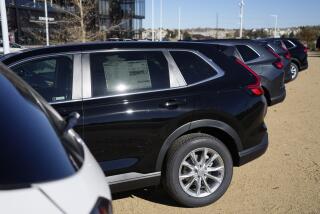Car Sales Decline but Retail Purchases of Other Goods Are Encouraging : Market Slide Effect Slight in 10.1% Auto Drop
DETROIT — Led by a big decline at General Motors, domestic auto sales fell 10.1% in early November, and analysts said they expect to see a further drop through the holidays and into next year.
Industry observers stressed Friday that there is little evidence the drop in sales was brought on by the Wall Street crash, but they still expect the stock market’s plunge to hurt domestic auto sales in coming months.
“There is no evidence yet, but then it is too early,” said Donald DeScenza, automotive analyst with Nomura Securities. “I’m inclined to think there will be a big effect, but I don’t think it shows up right away. Consumers resist changing their spending habits. There is a lag.”
Indeed, most analysts said the weak showing in early November was mainly a continuation of sales trends that predate the Oct. 19 market collapse.
They noted that the drop reflected ongoing problems at GM, which accounted for almost the entire decline in the period, as well as the typical sluggishness that the domestic industry experiences after its sales incentive programs expire. Detroit auto makers had offered low-interest financing on a broad range of products in September, but most of those programs were dropped at the beginning of October.
In addition, analysts pointed out that, since car sales figures reflect actual customer deliveries, some of the sales counted during early November represented orders placed before the crash.
“To be down this much is right in line with where they were before the crash,” added DeScenza. “There is nothing in these numbers to suggest the bottom has fallen out since the crash,” noted Steve Torok, a sales analyst at Chrysler. “It’s really an extension of the relatively weak level we had throughout October.”
Still, before the crash, most forecasters had been expecting some pickup in November sales over the October level; the fact that sales were only flat with the previous month’s pace may have been partly due to the crash, some analysts asserted.
More ominously, some car dealers in Southern California said that customer traffic in their showrooms has fallen off since the crash, a signal that sales figures reported in the next few weeks may show steeper declines.
“The market definitely has affected sales, especially Oldsmobile,” said John Sofranko, general sales manager for Albertson Oldsmobile in Culver City. “The floor traffic has been down.”
But the domestic industry has yet to show the sharp reaction to the stock market meltdown that hit the European luxury importers in late October.
With their affluent customers in the nation’s financial centers suddenly forced to rein in spending and cancel orders, German auto makers like Porsche and Mercedes-Benz posted steep declines in October.
GM ‘Culprit’
Although the imports did not post 10-day sales Friday, Porsche indicated that its crash-induced sales slump is continuing. On Friday, the German sports car maker announced that it would cut production and working hours at its German plants, noting that “the stock exchange crash of the past few weeks has led to caution among purchasers of luxury goods, especially in the American market.”
Meanwhile, for the domestic industry, GM was clearly the culprit behind the double-digit decline in early November. GM, which has suffered from low customer acceptance of its new products and plunging sales for over a year, posted an 18.6% drop in its sales of U.S.-built models.
But that steep decline at GM probably did not have much to do with the stock market. Cadillac, which sells the GM luxury cars most likely to be hurt by any fallout from the crash, was the company’s only passenger car division to post a sales gain during the period.
By contrast, Ford said its sales were off just 1.5%, while Chrysler reported a 2.2% decline. Honda, now the fourth-largest domestic auto maker, said its sales of U.S.- built cars rose 6.1%.
Volkswagen, which has become a relatively insignificant presence in the domestic industry in recent years, said its sales of U.S.-built cars fell 22.9% during the period, while Nissan turned in a 4.2% gain. Toyota, which produces cars jointly with GM in Fremont, Calif., reported a 205.1% increase on its relatively small volume of U.S.-built cars. Mazda, which has just opened its Flat Rock, Mich., assembly plant, reported domestic car sales for the first time during the period, and said it sold 68 U.S.-built cars in early November.
At the same time, sales of U.S.-built light trucks, which many consumers now substitute for passenger cars, surged during the period for all of the major auto makers. Light truck sales rose 30.3% during the period; combined, car and truck sales actually rose 2.2% in early November.
Some analysts pointed to the strong light truck numbers as evidence that middle-class consumers, who form the bulk of the truck market, have not yet significantly curtailed spending.
Ground for Optimism
“I think the numbers are pretty optimistic,” said William Pochiluk, an analyst with Autofacts, an automotive market research firm in Paoli, Pa. “The market obviously had some effect, but I don’t think it was nearly as precipitous as people were thinking. I don’t think it was that big of a number.”
Yet Pochiluk--along with every other industry analyst--remains cautious about the outlook for 1988 auto sales in the wake of the crash. All of the major research firms have reduced their forecasts for next year’s sales. Before the crash, most were anticipating combined import and domestic sales of about 10.5 million units, and now are generally predicting sales of between 9.5 million and 10.0 million.
AUTO SALES
Nov. 1-10 Nov. 1-10 % 10-Day 1987 1986 change GM 67,364 82,729 -18.6 Ford 40,877 41,492 -1.5 Chrysler 21,821 22,301 -2.2 Honda U.S. 6,425 6,055 +6.1 VW U.S.* 641 831 -22.9 Nissan U.S. 1,723 1,654 +4.2 Toyota U.S. 656 215 +205 Mazda ** U.S. 68 -- -- TOTAL 139,575 155,277 -10.1
*Estimate ** No comparable 1986 sales






